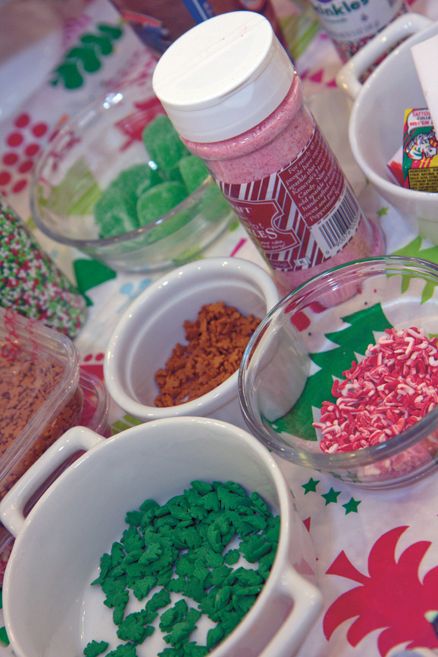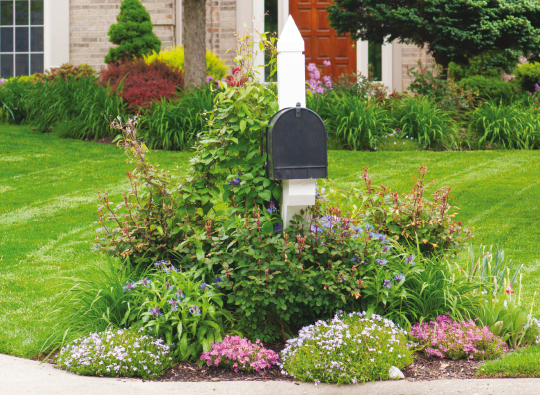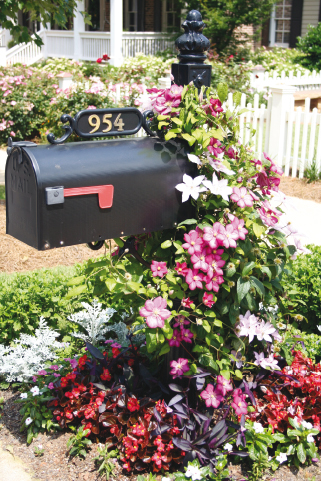Mailbox Gardens: Create a Special Place for Special Deliveries

 Everyone loves to receive a personal greeting in the mail. There’s something exciting about opening up the mailbox and spotting a hand-addressed envelope from a relative or an old friend amidst those unwelcome bills. The mailbox is also the first thing your guests see as they approach your home, so why not make the space around it a personal greeting in itself?
Everyone loves to receive a personal greeting in the mail. There’s something exciting about opening up the mailbox and spotting a hand-addressed envelope from a relative or an old friend amidst those unwelcome bills. The mailbox is also the first thing your guests see as they approach your home, so why not make the space around it a personal greeting in itself?
If you think about it, there is probably no place on your property that is frequented more by a visitor than your mailbox. Six days a week, we depend on our friendly neighborhood postal carrier stopping by. While your top priority should be to maintain your box, post, and land around it so that it is easily accessible for your carrier, you may also want to add curb appeal by sprucing up the space with plants or hardscapes.
A mailbox garden can be as simple or elaborate as you would like, just as long as it matches your style—and your level of devotion. If you have a long driveway, running a hose and sprinkler or irrigation system may not be possible, and you may not care to lug a watering can. In this case, choosing a few hardy perennials is best.
On the other hand, if you have a large front yard and are looking to cut down on some of the maintenance there, planning a big garden space around your mailbox with some mulch and attractive groundcover may actually help you out.
Whatever size you choose, it is important to note that your mailbox garden will need to meet all the challenges of a life on the street: motorists driving by, children running down the curb, deer paying a visit, and of course, dogs doing their thing. Here are some ideas for plants and hardscapes that are up for the job.
Designing, Planting
 The key to designing a small garden space around your mailbox is choosing plants that grow mostly up and not out. Be mindful of your postal carrier and don’t pick plants that spread too far or grow too tall. Make sure plants don’t cover numbers on your post or mailbox, and don’t impede raising the flag or opening the door.
The key to designing a small garden space around your mailbox is choosing plants that grow mostly up and not out. Be mindful of your postal carrier and don’t pick plants that spread too far or grow too tall. Make sure plants don’t cover numbers on your post or mailbox, and don’t impede raising the flag or opening the door.
Taller plants and bulkier shrubbery can play a role, though, if they are planted behind your post and serve as a backdrop for the shorter plants taking the stage out front. The taller plants could include everything from vines winding up a trellis (such as clematis), to an edge of boxwoods, to daylilies, iris, or any number of fuller and thicker ornamental grasses.
Many people choose ornamental grasses for their curbside gardens because they are mostly drought-tolerant, deer-tolerant, and don’t require much care. Because the mailbox is most often in full sun, the grasses will do well. At maturity, they will stay the same height so there is no pruning, and they create a nice contrast for your space. When choosing grasses, make sure you have a space that won’t be overwhelmed by them. They tend to look nice on a hillside, acting as a bridge from a sloping yard down to a road.
Though not an ornamental grass but often thought of as one, liriope (or lilyturf) is a good choice for a mailbox garden as it typically stays the same shape and size throughout its life and deer tend to avoid them. With purple flower spikes in late summer, they can add a splash of color, too.
Many bulbs generally are deer resistant, including daffodils, Dutch iris, and hyacinths. If deer are already a real problem for you, anything you put at the curb will be sure to attract their attention during their nighttime strolls through your neighborhood. If you are starting a new mailbox garden, you can train deer early by planting daffodils along with tulips.
 If dogs frequent your post, consider shrubbery like barberry. The varieties with sharp thorns are a natural deterrent for dogs and deer alike.
If dogs frequent your post, consider shrubbery like barberry. The varieties with sharp thorns are a natural deterrent for dogs and deer alike.
Groundcovers that don’t spread too much can also be a low-maintenance option for a simple garden, such as phlox.
Of course, if you want to add more color and don’t mind trekking out to the mailbox, you can plant annuals, but plan a regimen to phase them out as they begin to fade, replacing pansies with red salvia or white sweet alyssum, then adding mums in the fall. Your local nursery can advise you on which varieties will give you the longest run for your money.
To cut down on the maintenance, always remember to mulch well and use a newspaper or fabric underlay in your bed.
 Boxing in Your Box
Boxing in Your Box
Choosing your edging is where you can really get creative with your garden design. If you don’t have a curb, you can use simple stones to outline a round or square bed, being careful not to place them in the way of where you need to stand to open the box or where motorists, including your postal carrier, would be driving. You can also use the curb or street as one of the sides for a square or semi-circular space. Choose pavers or bricks—any hardscape that matches the style of your home. By stacking rock slabs, stones or pavers (in much the same way as a firepit), you can create a nice raised bed that will really set the stage for your mailbox as a focal point. If you have enough room and want to plan a larger garden, creating a low hedge with shrubbery in a semi-circle pattern behind the box can be equally attractive.
When you get to work on your garden, use that time to inspect your mailbox to see if it needs a fresh coat of paint, a new post, or a new set of numbers to identify your house.
Adding a beautiful garden space at your mailbox is an easy way to enhance your landscape year-round. Deliver on this project, and checking your mailbox for your own deliveries will be more enjoyable.
barberry, boxwoods, Clematis, curbside garden, Daffodils, daylilies, deer resistant, hyacinth, iris, mailbox garden






